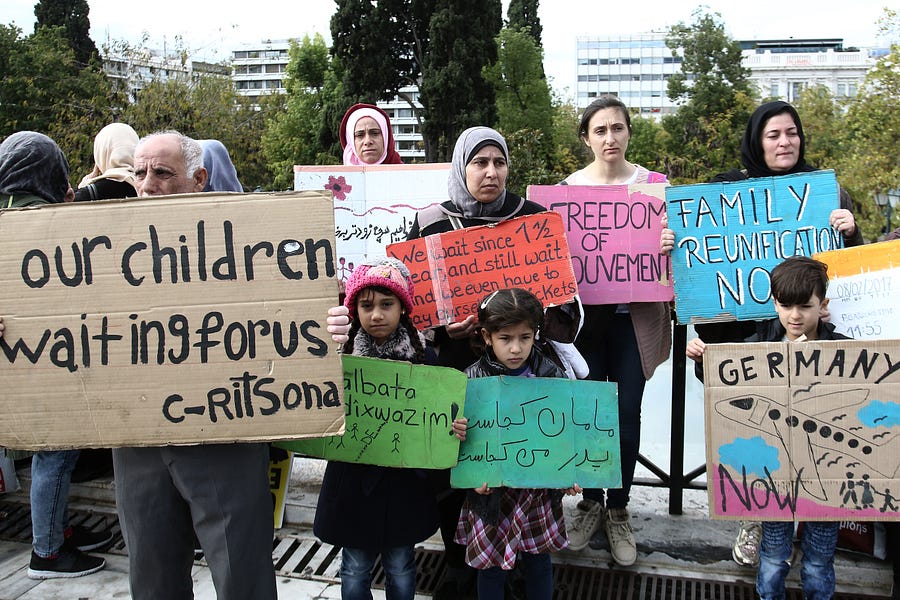A warning cry has begun that COVID will mean the end of immigration. On the surface, the numbers are stark: In July 2020, the U.S. Department of State issued 4,412 immigrant visas compared with 39,568 in July 2019, but the reality on the ground is different. It is not simply the ballooning migrant camps waiting on the Mexican side of the U.S.-Mexico border or the crush of inflatable dinghies crossing the English Channel, bearing African and Middle Easterners from France to Great Britain. It is that too many on both sides, the left and the right, have been lying about immigration: starting with the name.
Over the last decade, immigration has morphed into something else, now called by the dangerously deceptive term “migration,” which lumps together all routes of entry, lawful and unlawful. Thus far, the U.S. and Europe have avoided a real debate on what impact this new movement of human beings will have on the future of these countries and indeed our civilizations. We debate immigration and fences and walls when we should be debating migration.
It is a debate that we cannot avoid for much longer.
The first part of our “migration” problem is legal: Western Europe and the U.S. are still largely governed by a 1951 Convention Relating to the Status of Refugees, which was expanded in 1967 to cover anyone living in what can be considered a “dangerous” place. That definition allows potentially hundreds of millions of people worldwide to qualify as refugees. The U.N, High Commission on Refugees estimates that there were 26 million likely candidates for resettlement at the end of 2019. All that is needed is to arrive in a hospitable country and claim asylum.
For some, asylum is a legitimate claim, but for others, it is a scam. In 2012—years before the rise of Donald Trump—the FBI rounded up 30 immigration lawyers, paralegals, and interpreters who were part of a money-making scheme to secure asylum for thousands of Chinese migrants to the U.S. In Western Europe, the overall asylum request numbers are even higher. Between 2009 and 2018, Germany had more than 2,169,000 asylum seekers, followed by France at 729,880, Italy at 571,835, Sweden at 504,835, and Great Britain, which is an island, at 327,490. There are many documented cases of “asylum” migrants paying smugglers to convey them to their destination. CNN reported that in 2016 the going rate for someone from Kenya to be resettled in the U.S. as a refugee was between $10,000 and $20,000.
Consider the recent story of asylum-seeker Abdulfatah Hamdallah from another African nation, Sudan. In August, he drowned trying to cross the English Channel in a thin inflatable boat, using shovels for oars. His cousin told the Guardian that Hamdallah had left Sudan and reached Tripoli, Libya, with the help of smugglers. He worked in a car wash for two years and then set off for Europe. Hamdallah’s brother explained to the Guardian that, “He wanted to build his future, so he couldn’t stay in Sudan.”
But the desire to “build a future” is not what most of us think of when we think of asylum. Instead, it’s a status designed for those fleeing conflict or persecution. And after arrival to a new country, that future can be bleak. Not everyone is approved for asylum; many simply vanish into the vast underground. Migrant camps in France and Italy are considered awful and arrivals describe running from the local police. In Great Britain, COVID outbreaks have once again exposed a network of garment sweatshops making “fast fashion” and employing migrants in horrible conditions for less than half minimum wage. In the U.S., Central American migrants, who are often likely to claim asylum, face higher poverty rates, more menial and dangerous jobs, and far lower levels of education than other groups. Migrants from all over the world are also frequently victims of human trafficking, being forced into sex work or exploited as domestic labor.
Here, we arrive at the confluence of the worst of the lies around migration. The refugee/illegal migrant/asylum system runs parallel to the legal immigration system. This means that you can follow the accepted legal practices—or you can make every effort to bypass the line. By the numbers, millions do. After all, they are all considered “migrants.” And make no mistake, they are avidly encouraged in this pursuit, by virtue signaling on the left and crass opportunists on the right.
Despite COVID, more than 4,900 refugees primarily from African and Middle Eastern nations have crossed the English Channel to claim asylum in the U.K. this year, far more than in all of 2019. In AugustU.K. Home Secretary Priti Patel tweeted, “The number of illegal small boat crossings is appalling and unacceptably high. The figures are shameful. France and other EU states are safe countries. Genuine refugees should claim asylum there, not risk their lives and break the law by coming to the UK.”
The U.K. division of U.S. ice cream makers Ben and Jerry shot back a heated reply. “Hey @PritiPatel,” the company tweeted in a thread, “we think the real crisis is our lack of humanity for people fleeing war, climate change and torture….and once more for the back: PEOPLE CANNOT BE ILLEGAL.” Included in the thread was a link to a piece “Why ‘stronger’ borders don’t work.” But if people cannot be illegal, where do we draw the line or is there any line to draw?
The “open borders” crowd has an even larger presence in the U.S., starting with sanctuary cities and counties such as San Francisco and Montgomery County, Maryland. What does a “borderless U.S.” look like?
In Democratic vice presidential candidate Kamala Harris’ view, it is where all “undocumented immigrants” have access to full public health care and education. New Jersey Gov. Phil Murphy, is blazing another trail, having recently approved a law allowing some 500,000 “undocumented residents” in his state to become licensed “doctors, nurses, electricians, counselors, cosmetologists, and other professionals.” Apparently, in Harris and Murphy’s world, the U.S. is a land of unlimited resources, unlimited public tax dollars, and unlimited jobs.
But the right-leaning business community has not done much better. Too often, businesses—particularly food processing and construction—have been more than willing to employ undocumented workers, often for low wages in substandard conditions. A 2019 ICE raid on a Koch Foods chicken processing plant in Mississippi led to the arrest of 680 Hispanic workers who were living illegally in the U.S. Adding to the economic tensions, their jobs have since gone to local African American residents who needed work or better paying work.
Both sides have also turned a blind eye to the massive remittance economy, which sent $19.1 billion dollars out of the U.S. to Mexico alone in the first six months of 2020 (another $2.6 billion went to Bangladesh). Globally, according to the World Bank, $689 billion was transferred in 2019—primarily from individuals living in wealthy countries to those residing in middle or poorer ones. “Migration is health insurance, it’s unemployment insurance, it’s a giant risk mitigation strategy for the world’s poor,” Andrew Selee, president of the Migration Policy Institute, told the Washington Post in August.
But is that truly how we want to define immigration? Do we want it to be transformed into migration, where driven by inflated promises, crafty smugglers, and troubled homelands, more human beings will to do almost anything to reach an economic “promised” land—not to assimilate but to receive government benefits and to send money back to their “homes”? The future and the fabric of our nations, in the U.S. and Europe, depend on how we answer.
We should start now, by insisting all those running for national, state, and local office define their stance not on immigration, but on migration. Or we may be asking: is a nation of migrants even a nation at all?
Ayaan Hirsi Ali is a research fellow at the Hoover Institution and founder of the AHA Foundation. She served as a member of the Dutch Parliament from 2003-2006.






Please note that we at The Dispatch hold ourselves, our work, and our commenters to a higher standard than other places on the internet. We welcome comments that foster genuine debate or discussion—including comments critical of us or our work—but responses that include ad hominem attacks on fellow Dispatch members or are intended to stoke fear and anger may be moderated.
With your membership, you only have the ability to comment on The Morning Dispatch articles. Consider upgrading to join the conversation everywhere.